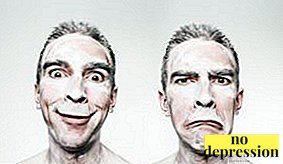In a broad sense, haptophobia is the fear of touching other people (acquaintances and strangers). This pathological condition refers to the rarest phobias in psychological and psychiatric practice.
Haptofobia to a large extent changes the quality of life and causes rapid human degradation.
A phobia changes character, has a negative impact on social adaptation and can provoke serious psycho-emotional disorders. There are several ways to deal with this ailment, but in most cases a qualified specialist help is needed.
What is the fear of touching?

Haptofobiya is an irrational fear of tactile touch other people.
The degree of familiarity with potential irritants does not matter.
A provoking factor can even be random touch stranger.
At risk are patients with an established diagnosis of autism. In this category of people, haptophobia is a kind of complication of the underlying disease.
A phobia can occur in people without mental disorders, but it will be extremely difficult to find out the specific causes of the phobic state.
In psychiatric practice, haptophobia may be referred to under several titles:
- haphophobia;
- hapnophobia;
- aphobia;
- afenfosmofobiya;
- gopofobiya;
- thixophobia;
- Haptephobia
Causes of fear

Numerous factors can provoke haptophobia.
In most cases, the phobia develops on the background progressive obsessive states.
For example, if there is a fear of contracting a certain disease from other people or the fear of pain they may cause.
A special place in the causes of haptophobia occupy children psycho-emotional trauma.
Children who are brought up in immoral conditions (excessive control by parents, experienced violent actions, etc.) are prone to phobias.
Main reasons Development phobias are the following factors:
- excessive suspiciousness and emotionality;
- a heightened sense of disgust;
- pathological control of the comfort zone;
- progression of psychoasthenia;
- propensity for excessive isolation;
- critical hormonal imbalance;
- specificity of professional activity;
- the progression of obsessive states;
- children's psychological trauma;
- rape consequences.
Types of manifestations

Haptophobia can be combined with other types of phobias.
In some cases, a person cannot explain the reasons for his own fear and experiences unreasonable discomfort during tactile contact with other people.
In other cases, the fear of touching has specific prerequisites.
For example, a haptophob may experience a fear of being infected with a disease or expect pain from tactile contact. Such phobic states in psychiatric practice have their names.
Forms of manifestation haptophobia:
- fear of pain (alhophobia);
- fear of infection and viruses (germphobia);
- fear of being infected with HIV (speedophobia);
- fear of sexual harassment (agraphobia);
- fear of body contamination (automysophobia);
- fear of people (anthropophobia);
- fear of bacteria (vermin phobia);
- microbial fear (misophobia).
Die from aids! Spidophobia:
How to recognize haptophobe?

In most cases, the manifestation of haptophobia resembles excessive disgust.
The haptophob tries to avoid tactile contacts and reacts painfully even to the occasional touches of other people (for example, standing in a queue at a store or moving in a crowd).
The reaction of a person with haptophobia to such factors can manifest itself in the form of a desire wash hands immediately or wipe them with wet wipes.
If tactile contact is carried out deliberately, then the hapto-phobic shows aggression and tries by all means to exclude touches to its own body.
Additional signs Haptofoba:
- a person tries to wear clothes made of thick fabrics, even in summer;
- Haptofobs avoid large crowds of people (public transport, shopping centers, etc.);
- tactile touches cause inadequate response.
Symptoms and signs
Symptoms of haptophobia occur when exposed to a specific stimulus - tactile contact. A phobia can manifest itself in the form of psychological or physical signs.
 The haptophob undergoes a negative reaction, which may be accompanied not only by inappropriate behavior, but also by unreasonable feelings (itching of the skin, pain, tingling in the area of touch).
The haptophob undergoes a negative reaction, which may be accompanied not only by inappropriate behavior, but also by unreasonable feelings (itching of the skin, pain, tingling in the area of touch).
In severe cases, tactile contact provokes a panic attack and a nervous breakdown.
In haptophobic tactile contact, the following the symptoms phobias:
- sensation of heat or itching of the skin;
- changes in facial expression and inadequate response;
- dizziness and headache;
- increased pulse and breathing;
- nausea or vomiting attack;
- shortness of breath and sudden chills;
- tremor and pallor of the limbs;
- feeling of anxiety and excitement.
What problems in life can create?
Haptofobiya is considered a mental disorder and can create numerous problems in social life.
People with such a phobia lead a secluded life and try by all means to avoid tactile contact with others.
They rarely leave the house, irritable and aggressive. Because of the fear of touching, haptophobes difficult to adapt to society.

Haptofobiya can provoke Problems in the following areas:
- personal life;
- professional activity;
- social adaptation.
How to overcome a phobia?
Treatment haptophobia involves several stages. The main method of dealing with the disease is the use of psychotherapeutic techniques.
In the absence of a result or a slowed down tendency to get rid of phobias, the need arises to correct the psycho-emotional state with special preparations.
In some cases cope with haptophobia succeeds by independent efforts using certain exercises. Only a qualified specialist (psychologist, psychotherapist) can determine the need for a specific phobia therapy tactic.
Medicines

Haptophobia in most cases becomes consequence of certain nervous disorders.
Drug therapy of this phobic condition is an essential stage of treatment.
The difference lies in the types of drugs required and the degree of effects on the patient's psyche. In severe cases, the patient may be hospitalized.
In the treatment of haptophobia, the following types are used medication:
- antidepressants (to stabilize the psycho-emotional state);
- hormonal drugs (to restore hormonal background when it fails);
- drugs from the category of benzodiazepines (inhibit the process of nervous excitement);
- means of the category of neuroleptics (sedative effect on the psyche and emotional state);
- sedatives (necessary when stopping panic attacks).
Psychological help
The use of psychotherapeutic and psychological techniques is the main way to treat haptophobia.
List of specific procedures, the frequency of their conduct and the duration of the course are determined by the specialist on the basis of the general state of the haptophobe and the reasons that provoked mental disorder.

Therapy can take a long time, but in most cases the predictions are favorable.
Psychotherapeutic techniques for haptophobia:
- Group classes (behavioral therapy aimed at eliminating fears, correction of psycho-emotional state and the development of new personal qualities).
- Hypnosis method (during this procedure, the specialist determines the specific cause of fear and selects ways to solve the problem, the impact on the haptophobe is carried out at the subconscious level).
- Individual sessions (procedures contribute to stopping the main fear and increase personal qualities).
Exercise yourself
Severe forms of haptophobia cope on their own is impossible. Specialist assistance is imperative for treatment.
However, at the first signs of a phobic state, you can use several techniques that will help not only to stabilize the psyche, but also eliminate the risk of further progression of the phobia.
Variants of treatments for haptophobia that can be done independently:
- First you need to learn control your fear and do not focus attention on stimuli (if tactile contact gives you discomfort, you must mentally imagine some pleasant or placating picture).
 It has good performance increase self-esteem and the expansion of personal qualities (for any success you have to praise yourself, looking in the mirror - making compliments, etc.).
It has good performance increase self-esteem and the expansion of personal qualities (for any success you have to praise yourself, looking in the mirror - making compliments, etc.).- If you have a tendency to phobias, psychologists and psychotherapists recommend yoga, swimming, breathing exercises (such methods have a calming effect and strengthen the nervous system).
- "Shock" treatment (it is necessary to be in public transport at rush hour, the method is dangerous and must be previously agreed with the doctor).
- When the first symptoms of haptophobia occur, you can try to sign up for partner dance (regular tactile contact can eliminate itself).
- Awareness of fears and obtaining maximum information about them (it is necessary to identify the specific object of your fear and try to minimize the risk of its danger, for example, if you are afraid of contracting any disease, it is important to understand that most infections do not affect a person with good immunity).
How to live with haptophobia?
Haptofobiya is a complex and dangerous phobic state, but it is not among the deadly ones (with the exception of serious complications in the form of mental illness). With timely and correct correction forecasts in most cases favorable.
If you ignore the phobia and do not attempt to get rid of it, the consequences can drastically change the quality of life of the haptophobe.
Recommendations in haptophobia:
 If it is impossible to control fear with your own efforts, then it is necessary to contact a specialist as soon as possible.
If it is impossible to control fear with your own efforts, then it is necessary to contact a specialist as soon as possible.- If you suspect a phobia, it is recommended to use sedatives and regularly conduct classes to eliminate fear and improve personal qualities.
- Some people live with haptophobia and do not seek to get rid of it, adjusting their lives (choice of professional activity, excluding tactile contacts, exclusion of visits to crowded places, etc.).
Haptofobiya in the absence of timely treatment can cause negative consequences for a man.
Phobia increases the risk of developing serious nervous disorders that can cause irreversible disturbances of psycho-emotional state. Panic attacks and aggression may not be controlled and appear unexpectedly.
How to get rid of the fear of infections and germs? Psychologist tips:

 It has good performance increase self-esteem and the expansion of personal qualities (for any success you have to praise yourself, looking in the mirror - making compliments, etc.).
It has good performance increase self-esteem and the expansion of personal qualities (for any success you have to praise yourself, looking in the mirror - making compliments, etc.). If it is impossible to control fear with your own efforts, then it is necessary to contact a specialist as soon as possible.
If it is impossible to control fear with your own efforts, then it is necessary to contact a specialist as soon as possible.

